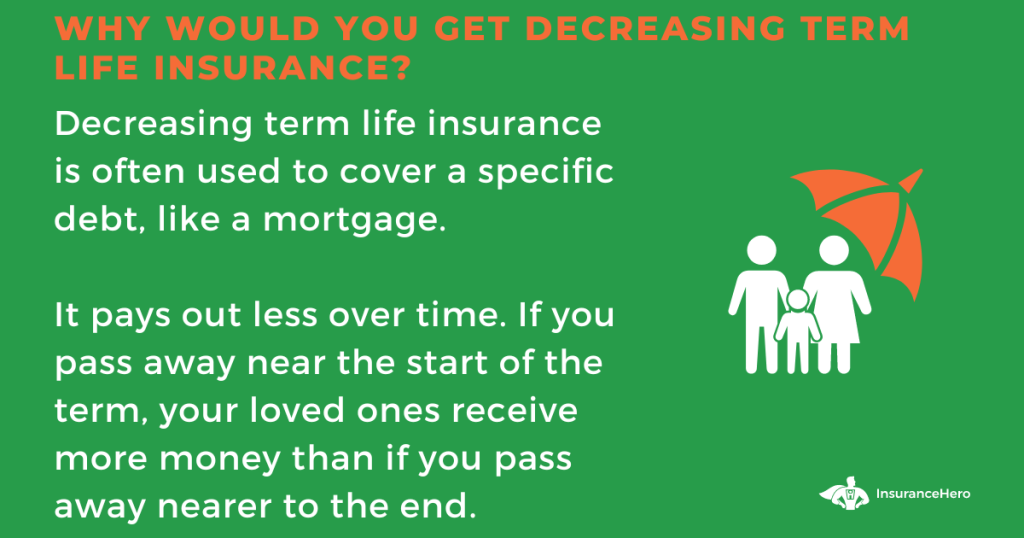Decreasing Term Life Insurance Explained: Policies & Quotes

A term life insurance policy that pays a lump sum is the most common type of life insurance available. The insured makes premium payments each month for a set period, called the term, which is usually 15, 20, or 25 years.
If the individual dies within the term, the policy pays a lump sum to the named beneficiaries.
A payment is not made if the individual is still alive when the term expires.
With decreasing term life insurance, the payout and the premiums decrease over time.
Premiums for term insurance are established when the policy is purchased and are based on the individual’s age, smoking, health status, selected term, and level of coverage.
Generally, premiums for term life policies are less expensive than those for whole life policies, which are always guaranteed to make a lump sum payout.
Individuals with a risky lifestyle, career, or hobbies sometimes pay higher premiums. Some insurance companies increase premiums if they discover that claim levels are unusually high.
Compare Top Quotes Today & Save £100s. Completely Free Service with No Obligation


What Is The Difference Between Increasing And Decreasing Term Life Insurance?
Term life insurance plans are one of the most popular types of life insurance policies. However, there are two different types of term life insurance: decreasing term life insurance and increasing term life insurance. So, what’s the difference?
Decreasing term life insurance is typically used to cover a specific debt, such as a mortgage. The death benefit decreases over time as the debt is paid off. Increasing term life insurance, on the other hand, is designed to keep up with inflation.
The death benefit increases over time, so it is always worth the same (or more) in today’s money.
Decreasing term life insurance is usually cheaper than increasing term life insurance. However, decreasing term life insurance may not provide enough coverage if you need it for more than a specific debt.
Increasing term life insurance is a way to get more coverage for the same price. Most people buy term life insurance when they are young and healthy, which is much cheaper than buying it later in life.
However, your health may change as you age, and you may not be eligible for the same rates. So, by increasing your policy now, you can lock in the lower rates while you are still healthy.
Life insurance payouts are tax-free, but if not set up correctly, they could become part of the estate. If an estate is large enough to be subject to inheritance tax, up to 40 percent of the insurance benefit could be taxable.
Therefore, consumers should consult a financial advisor before making large financial decisions like this. By effectively managing their finances, they reduce the burdens on surviving loved ones.
Reasons to Buy a Decreasing Term Life Policy
Life insurance benefits are designed to repay debts and provide financial support to surviving dependents upon the death of the insured. Though no one likes to think about death, it is inevitable. Leaving a sum to help smooth the transition upon your passing is a smart idea.
Mortgage companies require that mortgage holders with a spouse or children have a life insurance policy. A decreasing term policy is perfect because it is designed to pay off the mortgage when the insured dies. For this reason, decreasing term life insurance is also called mortgage life insurance.
If a spouse or partner does not work, it is even more important to provide for that person financially. While the individual may be able to get a job, there may be child and house care expenses to consider.
The life insurance payout can cover living expenses until the person earns a steady income.
Even someone without a spouse or children should consider this policy if there are other surviving family members.
It would be unfair to saddle them with debt that is not theirs. Providing enough money to repay existing debts is the considerate thing to do.

Choosing the Correct Policy
Since the benefit payout for a decreasing term policy declines over time, individuals must purchase a sufficient level of coverage at the start.
A popular guideline is the current balance on the mortgage since the payout is often used to repay this.
When reviewing policies, consumers must determine how much the payout will decrease each year. They can then use this information and the current mortgage balance to calculate the required level of coverage.
The coverage level should also reflect enough money to repay debts like credit card balances, auto loans, and personal loans and provide extra cash for survivors to apply toward living expenses.
Adults with minor children should also include enough money to cover daycare and higher education expenses.
Unfortunately, far too many people underestimate the total amount of money that surviving beneficiaries require.
Creating a budget that includes expected future expenses makes this task much easier. There is no need to go overboard because being over-insured results in higher premiums throughout the term.
Policy term is another factor that plays a big role. Most people select a term that lasts until the normal UK retirement age of 60 or 65. Those with young children select a term that runs until the children are financially independent.
Choosing a term longer than these timeframes is often wasteful because the insured will be living on a pension by that time. Individuals know how much coverage they need by combining a sufficient benefit level with an adequate term.
Pros and Cons of Decreasing Term Life Policies
A decreasing term life plan is cheaper than regular term life insurance. This makes it more affordable to consumers who want to leave enough money to repay a mortgage or another large debt.
As the balance on this debt decreases year after year, so does the lump sum payout provided upon the insured’s death. Options like critical illness insurance and a terminal illness clause can be added to the plan to cover other health-related situations.
Careful budgeting is necessary when purchasing this type of life insurance because the balance will be zero by the end of the stated term.
Surviving beneficiaries may become financially distressed if the insured dies within the term and the payout is insufficient to cover the mortgage and other debts.
If the benefit is not placed in trust, the payout may be delayed and could be subject to inheritance tax.
If the insured lives past the designated term, a payout will not be made. The policy will end and will not have a maturity value.
Payments must continue during the policy term, or coverage will be cancelled, and premiums will not be refunded.
If the policy does not feature a guaranteed premium, the premium may periodically increase upon review of the policy, which usually takes place every five years.
If you think decreasing term life insurance is right for you, use our online form to request quotes from the leading UK insurers. We will review the hundreds of plans available, saving you the time required for this research.
You will receive quotes for the coverage you want and can then compare the policies to find the most comprehensive plan for the least amount of money.


